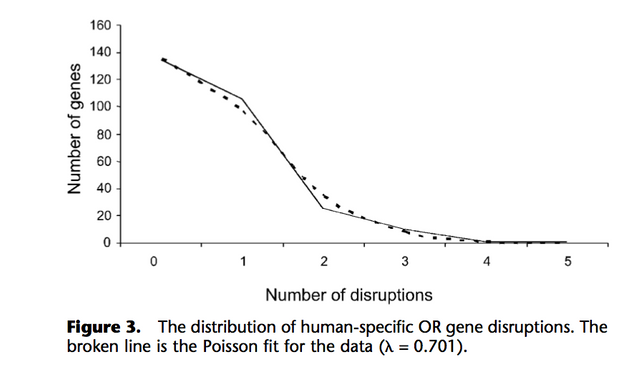The idea that there was a loss of functional olfactory receptor (OR) genes in Australopithecus, as a result of geographical isolation on the Danakil micro-continent, and a speciation to forage from the sea floor, is supported by that around 3.86 Ma[1], there was relaxation of darwinian selection for those olfactory receptor genes which have since deteriorated within the human lineage from the chimpanzee-human-last-common-ancestor (CHLCA) split.
Loss of olfaction in Australopithecus afarensis, 3.86 Ma
The chimpanzee genome was sequenced by 2005, and Gilad et al identified the entire chimpanzee olfactory receptor (OR) gene repertoire[1] from the publicly available sequence of the chimpanzee genome and compared it with the human one (which was first sequenced with The Human Genome Project, completed in 2003. )
They found that in agreement with previous reports based on a small number of ORs, humans have a significantly higher proportion of OR pseudogenes than chimpanzees. They also found that we can reject the possibility that humans have been accumulating OR pseudogenes at a constant neutral rate since the divergence of human and chimpanzee.
Based on the hypothesis of a neutral molecular clock, the study compared the number of mutations within OR pseudogenes that are shared between humans and chimpanzees, to the number of mutations within pseudogenes that are human-specific.

The mutations within the OR pseudogenes that are shared between humans and chimpanzees has a mean of 0.701 number of disruptions, accumulated over 6 million years since the CHLCA split, and the mutations in human-specific genes a mean of 0.451 number of disruptions. With a neutral molecular clock, the lower number of mutations in human-specific genes (λ = 0.451) shows that they have had less time to accumulate.[Notes]
With around 6 Myr since a common ancestor of the human and a chimpanzee genome, the time period over which mutations in the human-specific pseudogenes have accumulated is 0.701/0.451*6Ma = 3.86Ma, younger than both Ardipithecus kadabba (5.8 - 5.2Ma) and Ardipithecus ramidus (4.4Ma) as it is 2.14M after the chimpanzee-human-last-common-ancestor (CHLCA) split and around the time when Australopithecus afarensis appears in the fossil record (3.85-2.95Ma) along the Pliocene coast-line of Danakil.
References
Notes
- As a reference, this rate of neutral mutations would give a mean of 1 disruption per gene (λ = 1) over 6Ma/0.701 = 8.559Ma
This is so we can smell a rat when we see one. Example would be politicians.
Downvoting a post can decrease pending rewards and make it less visible. Common reasons:
Submit
A loss of OR genes would decrease the ability to smell a rat tough, no?
Downvoting a post can decrease pending rewards and make it less visible. Common reasons:
Submit
Possibly. LOL
Downvoting a post can decrease pending rewards and make it less visible. Common reasons:
Submit